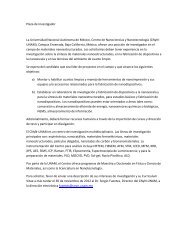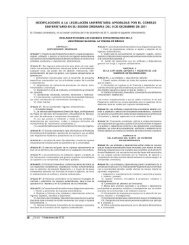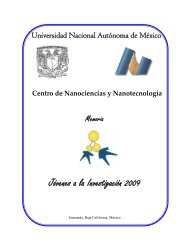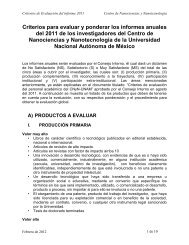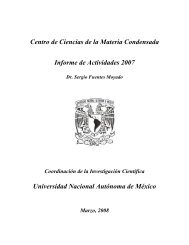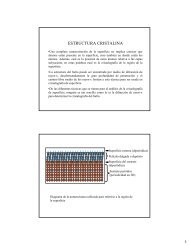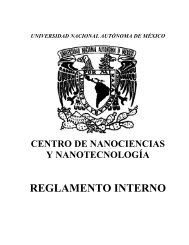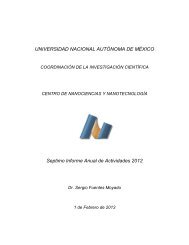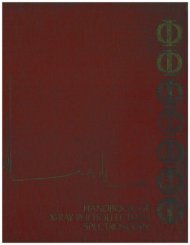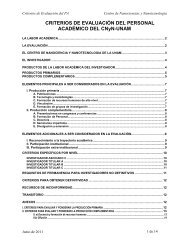Universidad Nacional Autónoma de México - CNyN
Universidad Nacional Autónoma de México - CNyN
Universidad Nacional Autónoma de México - CNyN
You also want an ePaper? Increase the reach of your titles
YUMPU automatically turns print PDFs into web optimized ePapers that Google loves.
1st International Symposium on Nanoscience and Nanomaterials<br />
O-004<br />
TEMPERATURE DEPENDENCE OF THE SPIN POLARIZATION RESPONSE IN SPIN-ORBIT<br />
COUPLED SYSTEMS<br />
Priscilla E. Iglesias Vázquez 1,a and Jesús A. Maytorena Córdova 2,b<br />
1 Posgrado en Física <strong>de</strong> Materiales, CICESE-UNAM. Ensenada, B.C., México.<br />
2 Centro <strong>de</strong> Nanociencias y Nanotecnología, UNAM. Ensenada, B.C., México.<br />
a piglesia@cnyn.unam.mx, b jesusm@cnyn.unam.mx<br />
Keywords: spin polarization, spin-orbit interaction, semiconductor spintronics.<br />
We investigate the temperature <strong>de</strong>pen<strong>de</strong>nce of the electric field-induced spin polarization of a twodimensional<br />
electron gas with Rashba and Dresselhaus spin-orbit interaction (SOI). The frequency-<strong>de</strong>pen<strong>de</strong>nt<br />
spin polarizability tensor for finite temperature is calculated using the linear-response theory; the cases of<br />
quantum wells grown in the main crystallographic directions are consi<strong>de</strong>red. The spin splitting caused by SOI<br />
opens the possibility of resonant effects involving electric-dipole transitions between the spin-split subbands<br />
as a response to alternating electric fields in the THz regime. Due to the anisotropic character of the SOI, the<br />
spin polarization response becomes <strong>de</strong>pen<strong>de</strong>nt on the direction of the applied electric field and presents<br />
characteristic spectral features only within the SO-induced energy window for optical absorption 1 ; this is in<br />
contrast to the case of pure Rashba or Dresselhaus case. At non-vanishing temperature this behaviour is<br />
modified, given that the optical inter-spin-split subbands transitions are then possible in a wi<strong>de</strong>r range of<br />
energies, beyond the sharp T=0 absorption edges. As a consequence, the spin <strong>de</strong>nsity response <strong>de</strong>creases<br />
monotonically with temperature for frequencies outsi<strong>de</strong> the mentioned window. We also study the effect of a<br />
temperature gradient in or<strong>de</strong>r to explore the spin Hall effect driven by the flow of heat. This raised new<br />
possibilities for spin current generation by means of heat currents and vice versa. This work was supported by<br />
DGAPA-UNAM IN114210 and CONACyT-México.<br />
1 Iglesias, P.E. y Maytorena, J.A. Anisotropic dynamical spin-<strong>de</strong>nsity response in quantum wells with spin-orbit interaction. Phys. Rev. B 82, 205324 (2010).<br />
O-005<br />
OPTICAL PROPERTIES OF TiO 2 /Al 2 O 3 NANOLAMINATES GROWN BY ATOMIC LAYER<br />
DEPOSITION<br />
Hugo Tiznado 1,a , Wencel <strong>de</strong> la Cruz 1,b , Gerardo Soto 1,c and David Domínguez 1,d<br />
1 Centro <strong>de</strong> Nanociencias y Nanotecnología – UNAM, Ensenada, Mexico.<br />
a tiznado@cnyn.unam.mx, b wencel@cnyn.unam.mx, c gerardo@cnyn.unam.mx, d david@cnyn.unam.mx<br />
Keywords: atomic layer <strong>de</strong>position, optical properties, thin films.<br />
Composite films whose refractive in<strong>de</strong>x can be adjusted by mixing two materials at different ratios<br />
are of consi<strong>de</strong>rable interest for optical and electronic applications [1]. In particular, those materials with<br />
potential to replace SiO 2 , as the gate oxi<strong>de</strong> in complementary metal–oxi<strong>de</strong>–semiconductors (CMOS), are<br />
currently being aggressively studied [2]. It is reported that the TiO 2 and Al 2 O 3 nanolaminates are able to tune<br />
their refractive in<strong>de</strong>x (n) and the extinction coefficient (k) by varying their individual thickness. However,<br />
only discrete values have been reported for specific light energies. In this work, it was employed the atomic<br />
layer <strong>de</strong>position (ALD) technique to prepare Al 2 O 3 /TiO 2 nanolaminates on silicon (111) substrates. The<br />
12




